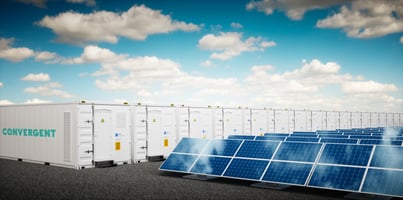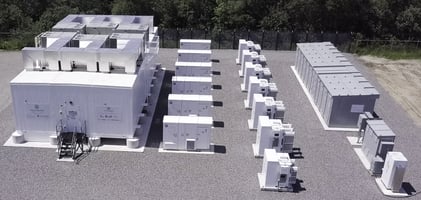Solar-Plus-Storage: The Key to a Reliable, Cost-Effective Clean Energy Future

As Convergent Energy and Power’s CEO, Johannes Rittershausen has said, “The sheer volume of solar power coming onto the grid is staggering, but its intermittency remains problematic, making it a raw asset in need of further refinement. Solar-plus-storage solutions mark an important new chapter in intelligently managing this important asset—storing it and precisely dispatching it when needed—to maximize environmental and economic benefit.”
As of 20251, solar power accounts for approximately 5% of the U.S. electricity supply, reflecting significant growth from previous years. Projections indicate that with continued policy support and technological advancements, solar could supply up to 40% of the nation's electricity by 2035.
Solar PV feeds the grid intermittently, whenever the sun’s rays can be converted into electricity. Many businesses and utilities are finding this intermittency, or inconsistency, challenging.
Solar-plus-storage (pairing solar with a battery storage system) is an optimal solution to solar’s intermittency, because the battery storage system can store solar energy when there is a surplus for times when there’s a deficit (like when it’s cloudy or the sun has set). Battery storage maximizes the value of solar energy, both by “firming” the intermittency and maximizing its financial value. In addition, adding battery storage to solar PV can help us accelerate the clean energy transition.
In this blog we will cover how solar-plus-storage is growing among businesses and utilities by allowing solar energy to be stored and dispatched at the most strategic times, increasing reliability and reducing energy costs.
Energy Storage 101: A Quick Primer
Before diving in, what exactly is energy storage?
Energy storage systems allow electricity to be stored—and then discharged—at the most strategic times. Today, Lithium-ion batteries, the same batteries that are used in cell phones and electric vehicles, are the most commonly used type of energy storage. Like the batteries in your cell phone, utility-scale battery energy storage systems can be charged with electricity from the grid, stored, and discharged when there is a deficit in supply or when energy is most expensive.
Why is Solar-Plus-Storage so Beneficial?
Solar panels only generate electricity when the sun is shining. When battery storage is paired with solar PV, the battery storage system stores solar energy when there is a surplus and can discharge that solar energy back onto the grid whether or not the sun is shining. Why does this matter? Because humans, of course, do not only use electricity when the sun is out. In addition to maximizing the value of solar, pairing solar PV with a battery storage system can also reduce energy costs (storing electricity when it is cheapest and discharging when it is most expensive).

Three Reasons to Add Battery Storage to Your Solar PV System
Adding battery storage to your commercial on-site solar power system is a numbers game. When you save on your overall electricity bill, you definitely come out ahead. Here are three reasons to add battery storage to your solar PV:
REASON #1: Use Solar Power When You Need it Most (Even if it’s Cloudy)
Most utilities have time-based rates for commercial and industrial (C&I) customers, which means you pay more when the grid is delivering at its peak capacity. For summer-peaking utilities, that’s generally late afternoon.
With a battery energy storage system connected to your solar array, you can store some of your solar generation when rates are low and discharge the battery to lower your grid-supplied energy consumption when grid power costs rise. This is known as time shifting your energy usage, and it’s a great way to improve the ROI on your solar investments.
 You can charge your battery storage with your solar generation, then discharge the battery storage to get solar power when you want it.
You can charge your battery storage with your solar generation, then discharge the battery storage to get solar power when you want it.
In the graph above, an industrial customer with higher electricity costs between 4:00 p.m. and 9:00 p.m. uses solar power to charge a battery storage system from 7:00 a.m. until noon. Later in the day, this same facility uses that stored power to extend use of its solar generation into those high-priced hours, thereby lowering power costs overall, as shown by the blue shape in the top right quadrant of the graphic.
REASON #2: Supersize Your Solar
If you’re a utility with a large solar system and no associated battery storage, you have a constraint: You can only generate as much solar power as the transmission lines and grid interconnection you’re using can accommodate.
The same is true for a business with solar power installed. You can only have as much solar energy as you’re able to use at your own peak consumption level. Again, you have a constraint, and it may mean you’re stuck using grid power for part of the day when you’d rather be relying on your own clean, lower-cost, energy.
 When your solar generation is limited by a constraint, such as your site’s peak consumption or power line capacity, storage lets you upsize solar and bank excess power for later use.
When your solar generation is limited by a constraint, such as your site’s peak consumption or power line capacity, storage lets you upsize solar and bank excess power for later use.
With battery storage, you can bank additional generation that would exceed your constraint, giving you the chance to install a bigger solar array and gain more value from your solar investment.
REASON #3: Manage Outages and Grid Interruptions
Electricity can move at nearly the speed of light, which means that without battery storage, it is used in the same instant it’s generated. Consequently, energy generation and energy usage must be in balance. When it’s not, the imbalance causes dips and spikes in voltage, which can damage many machines used in industrial processes.
Even a passing cloud that impedes solar generation can be problematic. Generation capacity drops. If your consumption doesn’t, it can impact facility voltage.
A combined solar PV and battery storage system can adjust for any dips in generation that weather creates. The process of managing those small deviations in generation capacity that passing clouds create is called “solar smoothing.”
Energy storage can also allow you to disconnect your facility from the grid and keep your equipment running for a pre-determined time period.
 Battery storage can discharge instantly to smooth dips in solar generation or outages and provide uninterrupted power.
Battery storage can discharge instantly to smooth dips in solar generation or outages and provide uninterrupted power.
If you need power during later hours of the day when solar generation decreases, you can benefit from adding a battery storage system to your solar PV. This is “energy firming,” the process of maintaining the output from your solar installation for a required length of time. Put another way, it is making sure enough energy is always available when you need it. For all these reasons, solar energy and battery storage are better together.
How to Get Started on Your Solar-Plus-Storage System
With over a decade of expertise financing, developing, and operating energy storage and solar-plus-storage, Convergent’s solar-plus-storage systems are an important part of our mission to build an energy landscape that is less expensive, more reliable, and increasingly sustainable—one that benefits our employees, our communities, our customers, and our planet.
If your organization is interested in learning more about solar-plus-storage—or if you have an existing solar system you would like to add energy storage to, please reach out to us.


